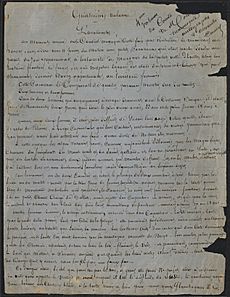Alexandre Dumas facts for kids
Quick facts for kids
Alexandre Dumas
|
|
|---|---|
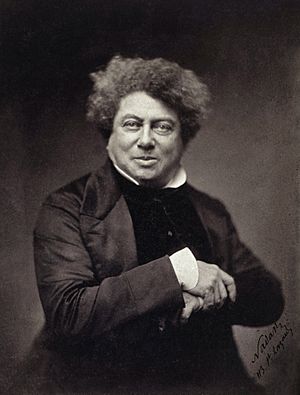
Dumas in 1855
|
|
| Born | Dumas Davy de la Pailleterie 24 July 1802 Villers-Cotterêts, Picardy, France |
| Died | 5 December 1870 (aged 68) Dieppe, Normandy, France |
| Occupation | Novelist, playwright |
| Period | 1829–1869 |
| Literary movement | Romanticism and historical fiction |
| Notable works | The Three Musketeers (1844) The Count of Monte Cristo (1844–1845) |
| Spouse |
Ida Ferrier
(m. 1840; died 1859) |
| Children | Alexandre Dumas fils (son) |
| Parents | Thomas-Alexandre Dumas |
| Relatives |
|
| Signature | |
 |
|
Alexandre Dumas (born Dumas Davy de la Pailleterie, 24 July 1802 – 5 December 1870), also known as Alexandre Dumas père (meaning "father"), was a famous French writer. He wrote many novels and plays.
His books have been translated into many languages. He is one of the most widely read French authors in history. Many of his exciting historical novels were first published in parts, like a TV show today. These include The Count of Monte Cristo and The Three Musketeers. Since the early 1900s, almost 200 movies have been made from his stories.
Dumas started his career writing plays, which were very successful. He also wrote many magazine articles and travel books. In total, his published works filled 100,000 pages! In the 1840s, Dumas even started his own theater in Paris called the Théâtre Historique.
His father, General Thomas-Alexandre Dumas, was born in the French colony of Saint-Domingue (now Haiti). His father was a French nobleman, and his mother, Marie-Cessette Dumas, was an enslaved African woman. When Thomas-Alexandre was 14, his father brought him to France. He went to a military school and had a very successful career in the army.
Young Alexandre got a job working for Louis-Philippe, Duke of Orléans, thanks to his father's high rank. This helped him start his writing career, which quickly became successful. Later, after Louis-Napoléon Bonaparte became president in 1851, Dumas left France for a few years. He lived in Belgium, then Russia, and later Italy. In 1861, he started a newspaper called L'Indépendent, which supported Italian unification. He returned to Paris in 1864.
Alexandre Dumas had several children. He supported his son, Alexandre Dumas fils, who also became a successful writer.
Contents
Early Life and Family

Alexandre Dumas was born in 1802 in Villers-Cotterêts, France. He had two older sisters. His parents were Marie-Louise Élisabeth Labouret and Thomas-Alexandre Dumas.
Thomas-Alexandre was born in Saint-Domingue (now Haiti). His father was a French nobleman, and his mother, Marie-Cessette Dumas, was an enslaved woman of African descent. Thomas-Alexandre was brought to France by his father and became a free man. He received some education and joined the French army. He did very well and became a general by age 31. He was the first soldier of African-Caribbean background to reach such a high rank in the French army.
Thomas-Alexandre used "Dumas" as his last name. This name is often thought to be his mother's surname.
Writing Career
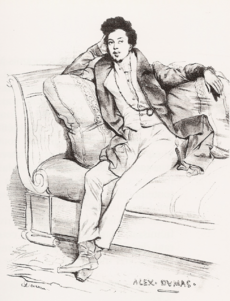
While working for Louis-Philippe, Dumas began writing for magazines and theaters. He used his grandmother's surname, Dumas, just like his father did. His first play, Henry III and His Court, was performed in 1829 when he was 27. It was a big success. His second play, Christine, was also very popular. These successes gave him enough money to become a full-time writer.
In 1830, Dumas took part in the July Revolution. This event removed King Charles X from power and replaced him with Louis-Philippe, Dumas's former boss. Life in France was a bit unstable for a few years, but as things settled down, the country began to grow with new industries. This time was good for Dumas's writing skills.
After writing more successful plays, Dumas started writing novels. He loved an expensive lifestyle and often spent more money than he earned. Newspapers at the time were publishing many novels in parts, like a series. Dumas's first serial novel was La Comtesse de Salisbury in 1836. In 1838, he turned one of his plays into a successful historical novel called Le Capitaine Paul ('Captain Paul').
He set up a writing studio with other writers who helped him create many stories. Dumas guided, edited, and added to all of them. From 1839 to 1841, Dumas and his friends put together Celebrated Crimes, a collection of essays about famous criminals and crimes in European history. Dumas also worked with his fencing teacher, Augustin Grisier, on his 1840 novel, The Fencing Master. This story is about Grisier witnessing the Decembrist revolt in Russia. The novel was later banned in Russia, and Dumas couldn't visit the country until after the Czar died.
Dumas worked with many assistants, and Auguste Maquet was the most famous. Dumas wrote the short novel Georges (1843), which had ideas and plots later used in The Count of Monte Cristo.
Dumas's novels became very popular and were quickly translated into English and other languages. His writing earned him a lot of money, but he often had financial problems because he spent so much. In 1846, he built a large country house outside Paris called the Château de Monte-Cristo. It had a special building just for his writing studio. This house was often full of guests who stayed for long visits and enjoyed his generosity. Two years later, he had to sell the property because of money troubles.
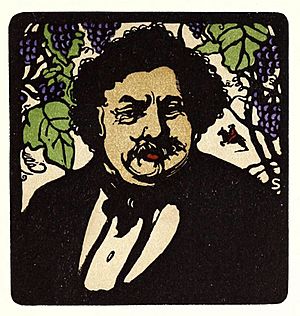
Dumas wrote in many different styles and published 100,000 pages in his lifetime. He used his travel experiences to write books about his journeys. Dumas traveled to Spain, Italy, Germany, England, and French Algeria. After King Louis-Philippe was removed from power, Louis-Napoléon Bonaparte became president. Dumas left France in 1851 for Brussels, Belgium, partly to avoid his creditors. Around 1859, he moved to Russia, where French was a popular second language among the upper class, and his writings were very well-liked. Dumas spent two years in Russia, visiting many cities. He published travel books about Russia.
In March 1861, the Kingdom of Italy was formed. Dumas traveled there and for the next three years, he supported the movement for Italian unification. He started and ran a newspaper called Indipendente. While there, he became friends with Giuseppe Garibaldi, a famous Italian general. Dumas returned to Paris in 1864 and published travel books about Italy.
Even with his success, Dumas faced discrimination because of his mixed-race background. In 1843, he wrote the short novel Georges, which explored issues of race. His response to a man who insulted him about his African ancestry became famous:
My father was a mulatto, my grandfather was a Negro, and my great-grandfather a monkey. You see, Sir, my family starts where yours ends.
Personal Life
On 1 February 1840, Dumas married actress Ida Ferrier. They did not have any children together.
Death and Legacy
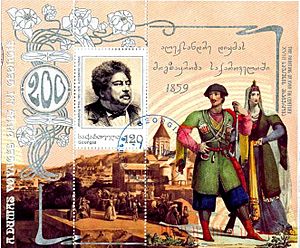
Alexandre Dumas died on 5 December 1870, at the age of 68. He was buried in his hometown of Villers-Cotterêts. His death happened during the Franco-Prussian War, so it wasn't widely noticed at the time. Later, his popularity decreased as new types of literature became popular. However, in the late 20th century, scholars like Reginald Hamel and Claude Schopp helped people appreciate his work again. They even found some of his lost writings.
In 1970, 100 years after his death, the Paris Métro (Paris subway) named a station after him: Alexandre Dumas station. His country home, the Château de Monte-Cristo, has been restored and is now a museum open to the public.
Researchers continue to find Dumas's works. For example, the five-act play The Gold Thieves was found in 2002 by scholar Réginald Hamel. It was published in France in 2004.
Frank Wild Reed (1874–1953), a pharmacist from New Zealand, collected the largest number of Dumas books and manuscripts outside France. His collection has about 3,350 books, including 2,000 pages written by Dumas himself. This collection was given to Auckland Libraries after Reed's death.
In 2002, for the 200th anniversary of Dumas's birth, French President Jacques Chirac held a special ceremony. Dumas's ashes were moved to the Panthéon, a famous building in Paris where many important French people are buried. The event was shown on TV. Dumas's new coffin was covered in blue velvet and carried on a special carriage. Four guards dressed as the Musketeers walked beside it. In his speech, President Chirac said:
With you, we were D'Artagnan, Monte Cristo, or Balsamo, riding along the roads of France, touring battlefields, visiting palaces and castles—with you, we dream.
Chirac noted that while France has many great writers, no one has been read as widely as Dumas. His novels have been translated into nearly 100 languages and have inspired over 200 movies.
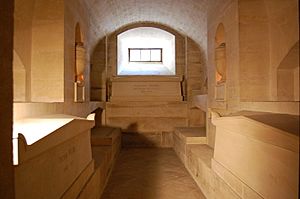
In June 2005, Dumas's last novel, The Knight of Sainte-Hermine, was published in France. Dumas had almost finished it before he died in 1870. Scholar Claude Schopp found a letter in 1990 that led him to this unfinished work. It took him years to research and edit it. Schopp wrote the final two-and-a-half chapters based on Dumas's notes to complete the story. The book became a bestseller and was translated into English as The Last Cavalier.
Works
Fiction
Adventure Stories
Alexandre Dumas wrote many exciting adventure stories and historical novels. Some of them include:
- The Countess of Salisbury (1836)
- Captain Paul (1838)
- Othon the Archer (1840)
- The Fencing Master (1840)
- The Corsican Brothers (1844)
- The Black Tulip (1850)
- The Mohicans of Paris (1854)
- The Prussian Terror (1867), set during the Seven Weeks' War.
Fantasy Stories
- The Nutcracker (1844): This is Dumas's version of Hoffmann's story The Nutcracker and the Mouse King. This story was later used for the famous The Nutcracker ballet music by Pyotr Ilyich Tchaikovsky.
- The Pale Lady (1849): A vampire story about a Polish woman.
- The Wolf Leader (1857): One of the first werewolf novels ever written.
Dumas also wrote many series of novels:
Monte Cristo Series
- Georges (1843): The main character in this novel is a man of mixed race. This was a rare hint at Dumas's own African background.
- The Count of Monte Cristo (1844–46)
The D'Artagnan Novels
This is Dumas's most famous series:
- The Three Musketeers (1844)
- Twenty Years After (1845)
- The Vicomte de Bragelonne, also known as Ten Years Later (1847). This book is often split into three parts in English: The Vicomte de Bragelonne, Louise de la Valliere, and The Man in the Iron Mask. The last part is the most well-known.
Related Books
- Louis XIV and His Century (1844)
- The Women's War (1845)
- The Count of Moret; The Red Sphinx; or, Richelieu and His Rivals (1865–66) -
The Valois Romances
The Valois family was the royal family of France from 1328 to 1589. Dumas wrote several romances about their time.
- La Reine Margot, also called Marguerite de Valois (1845)
- La Dame de Monsoreau (1846)
- The Forty-Five Guardsmen (1847)
- Ascanio (1843). This book is about King Francis I, but the main character is the Italian artist Benvenuto Cellini.
- The Two Dianas (1846), a novel about Gabriel, comte de Montgomery, who accidentally killed King Henry II.
The Marie Antoinette Romances
This series of novels is about Queen Marie Antoinette and the French Revolution.
- Joseph Balsamo (1846–48)
- The Queen's Necklace (1849−1850)
- Ange Pitou (1853)
- The Countess de Charny (1853–1855)
- Le Chevalier de Maison-Rouge (1845)
The Sainte-Hermine Trilogy
-
- The Companions of Jehu (1857)
- The Whites and the Blues (1867)
- The Knight of Sainte-Hermine (1869). This was Dumas's last novel, which was finished by scholar Claude Schopp after Dumas's death. It was published in English in 2008 as The Last Cavalier.
Robin Hood Series
- The Prince of Thieves (1872, published after his death). This book is about Robin Hood.
- Robin Hood the Outlaw (1873, published after his death). This is a sequel to Le Prince des voleurs.
Plays
Even though he is best known for his novels today, Dumas first became famous as a playwright. His play Henri III et sa cour (1829) was one of the first great Romantic historical plays performed in Paris. It was a huge success and started his career. Some of his plays include:
- Henry III and His Court (1829)
- Christine – Stockholm, Fontainebleau, and Rome (1830)
- Napoleon Bonaparte or Thirty Years of the History of France (1831)
- Antony (1831)
- Kean (1836), based on the life of the famous English actor Edmund Kean.
- Caligula (1837)
- The Gold Thieves (after 1857): This five-act play was found in 2002 and published in 2004.
In the 1840s, Dumas started his own theater, the Théâtre Historique, in Paris.
Nonfiction
Dumas wrote many nonfiction works. He wrote articles about politics and culture, and books about French history.
His long book Grand Dictionnaire de cuisine (Great Dictionary of Cuisine) was published after he died in 1873. It's a mix of an encyclopedia and a cookbook, showing Dumas's interest in food.
He was also known for his travel writing. These books include:
- Impressions de voyage: En Suisse (Travel Impressions: In Switzerland, 1834)
- De Paris à Cadix (From Paris to Cadiz, 1847)
- Travel Impressions in Russia (1859–1862)
- Voyage to the Caucasus (1858–1859)
Dumas Society
In 1971, French historian Alain Decaux started the "Société des Amis d'Alexandre Dumas" (The Society of Friends of Alexandre Dumas). This society helps take care of the Château de Monte-Cristo, Dumas's old country house, where the society is now located. The society also brings together Dumas fans and collects books, manuscripts, and other items related to him.
Images for kids
-
Alexandre Dumas and Adah Isaacs Menken, 1866
See also
 In Spanish: Alejandro Dumas para niños
In Spanish: Alejandro Dumas para niños
- Alexandre Dumas Museum
- Black Europeans of African ancestry
- Illegitimacy in fiction






